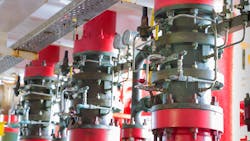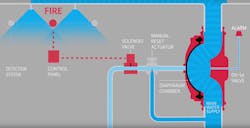Four Ways to Improve Fire Suppression System Reliability
Fire suppression system failure can damage property and result in loss of human life. For these reasons, end-users depend on component manufacturers and installation technicians to ensure fire suppression systems—like fire pumps, deluge and preaction systems, inert gas and dry chemical systems and more—are installed correctly and operate properly. Selecting the right fluid system components, including the valves, represents a critical step in the system design process. Original equipment manufacturers (OEM) and installers should carefully consider their options to increase fire suppression system reliability and lower costs.
To select valves that meet the needs of modern fire suppression systems, there are four steps which should be followed:
1. Look For Lab-Tested Components
Rigorous lab tests which encompass both in-house testing and third-party validation are a good indication of valve durability and will provide OEMs and installers with the peace of mind that a fire suppression system will operate as it should. Always look for fluid control components that carry applicable approvals from global agencies, standards organizations and equipment directives. It is also a good idea to work with solenoid valve suppliers that perform life cycle tests to ensure the durability of their components.
Although in an ideal world a fire suppression system is rarely—if ever—needed, in order for it to work properly, the system should be certified to the correct National Fire Protection Association (NFPA) standard. You should also verify that the solenoid valve has undergone relevant third-party testing. Some examples include:
- FM 7400: Liquid and Gas Safety Shutoff Valves. This standard sets performance requirements for liquid and gas safety shutoff valves used in the supply lines of commercial and industrial burners, as well as in ignitable liquid piping systems.
- CSA 22.2: General Requirements for the Canadian Electrical Code. This standard pertains to the installation and maintenance of electrical equipment in Canada.
- ANSI Z21.21: Automatic Valves for Gas Appliances. This standard applies to automatic valves with operating gas pressure ratings from 3.5-413.7 kPa.
Another important standard to look for is UL 429A: Electrically Operated Valves for Fire Protection Service. The requirements of this standard cover electrically operated valves intended for use in fire service systems, such as sprinkler systems, installed in accordance with the NFPA 13 Standard for the Installation of Sprinkler Systems. For example, ASCO valves that meet the UL 429A standard include the phrase “Actuating Valve” on the valve’s nameplate.
Additional tests to look for that fall under the UL 429A standard include the following:
- Switch endurance testing to 6,000 cycles.
- Overpressure testing, meaning the valve must be able to withstand twice its maximum rated operating pressure differential.
- Undervoltage operation testing at 65% of the rated voltage.
- High and low temperature endurance testing to 3,000 cycles at the maximum-rated temperatures and 3,000 cycles at the minimum rated temperatures.
- Seat leakage testing, immediately following the low temperature endurance tests, with no evidence of leakage.
2. Prioritize Parts Availability
Many OEMs and installers will need to provide ongoing maintenance and upgrades to existing fire suppression systems. Due to how critical safety is in the applications these technologies are used in, the system’s parts must be available when needed. For these reasons, it’s a good idea to partner with a valve supplier that has an extensive selection of parts in a wide range of pressure ratings, sizes and materials to accommodate different environments.
3. Don’t Overlook Your Supplier’s Ability to Customize
Facility requirements are always changing. The demand for highly efficient systems, along with modern building designs, can create challenges for fire suppression system installers. In addition, consider vendors that offer short-term or just-in-time delivery programs, which can cut lead times for part installations or replacements. Installers may need to fit castings into tight spaces or use a valve that meets specific pressure, voltage, power or frequency requirements.
It’s important to work with fluid component suppliers that have the engineering expertise to meet non-standard system designs. These suppliers should be able to provide different types and sizes of components that might not be listed in their catalog. Because many facilities have their own unique requirements, vendors should be able to design, test and deliver valve assemblies that are tailored to a specific site’s needs.
4. Stay Up-to-Date With the Latest Standards
To ensure greater safety to end-users, governing agencies will periodically update their standards. In the fire suppression system market, changes to standards are intended to minimize system failure and reduce the risk and financial repercussions of life-threatening incidents.
The most recent NFPA 13 standard, for example, now requires that solenoid valves have a supervisory feature that notifies the control panel if and when someone removes the coil. According to NFPA 13 section 8.3.1.2.1, “Effective January 1, 2021, removal of an electric actuator from the preaction or deluge valve that it controls shall result in an audible and visual indication of system impairment at the system releasing control panel.” Staying up-to-date with these and other changes will ensure the fire suppression system is offering the highest levels of safety and reliability.
Compared to other market solutions, which utilize an electronic approach to supervise the coil, the safest, most accurate valves incorporate non-contacting sensing switch design that detects correct assembly and lowers the chance for human error during installation. Some advantages of this solution include the following:
- More accurate detection as it uses a physical switch versus an inductance and continuity monitoring approach. This latter design uses an algorithm to detect changes in those parameters.
- The junction box containing the switch reduces the chance that outside contamination will affect the switch.
- The switch comes integrated with the coil and valve, eliminating the need for other external components and saving valuable installation time, space and costs.
- The spring design ensures the coil is properly installed, preventing incorrect or improper installation.
Looking Ahead
As the fire suppression market continues to evolve, there will be more opportunities to upgrade these safety-critical systems to offer data-capturing and diagnostic capabilities. One simple example is to connect a valve’s required supervisory feature to a dashboard, enabling end-users to receive real-time notifications and other system data. In addition to improving operational reliability, these digital enhancements will ensure your fire suppression system is ready for the future.
Georges Mankarious is product marketing manager at Emerson. He has a BSc in mechanical engineering from the American University in Dubai.
Comparing Fire Suppression Systems
Fire pumps work by increasing the pressure of water flowing from the utility supply to the distributed sprinkler systems. Found in many large commercial and industrial buildings, these systems utilize two-way solenoid valves to start and stop the flow of water to the pump engine. Pump controllers control and operate the fire pumps by communicating with a fire detection and automatic sprinkler system. These controllers utilize two-way solenoid valves as a test drain to simulate the pressure loss that occurs when a sprinkler system is activated.
Deluge and preaction systems use valves to release water from a utility supply or fire pump to a distributed sprinkler system. These electric systems are piloted by two- and three-way solenoid valves that open as soon as they receive either a pneumatic or electrical signal.
Inert gas and dry chemical fire suppression systems use chemicals, stored in either one large tank or a series of smaller tanks, to extinguish fires in situations where water could potentially damage critical infrastructure. These systems utilize two-way solenoid valves as release mechanisms, distributing the extinguisher to the appropriate sprinkler head.
About the Author
Georges Mankarious
Product Marketing Manager, Emerson
Georges Mankarious is product marketing manager at Emerson. He holds a BSc in mechanical engineering from the American University in Dubai.

Leaders relevant to this article:


